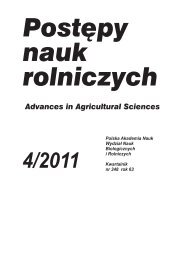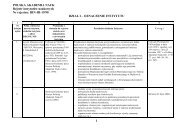Postepy nauk rolniczych - Instytucja Naukowa - Polska Akademia ...
Postepy nauk rolniczych - Instytucja Naukowa - Polska Akademia ...
Postepy nauk rolniczych - Instytucja Naukowa - Polska Akademia ...
Create successful ePaper yourself
Turn your PDF publications into a flip-book with our unique Google optimized e-Paper software.
64 E.U. Kozik, I. Ostrzy¿ek, W. Szczechura[13] Foolad M.R., Sharma A., Ashrafi H., Lin G.Y. 2005. Genetics of early blight resistance in tomato. ActaHorticulturae 695: 397–406.[14] Gilchrist D.G., Grogan R.G. 1975. Production and nature of host specific toxin from Alternaria alternata f.sp.lycopersici. Phytopathology 66: 165–171.[15] Gardner R.G., Shoemaker P.B. 1999. ‘Mountain Supreme’ early blight-resistant hybrid tomato and its parents,NC EBR-3 and NC EBR-4. HortScience 34: 745–746.[16] Hammond-Kosack K.E., Jones J.D.G. 1996. Resistance gene-dependent plant defense responses. Plant Cell 8:1773–1791.[17] Henning R.G., Alexander L.J. 1959. Evidence of existence of physiologic races of Alternaria solani. Plant Dis.Rep. 43: 298–308.[18] Langsdorf G., Furuichi N., Doke N., Nishimura S. 1990. Investigations on Alternaria solani infections:detection of alternaric acid and a susceptibility-inducting factor in the spore-germination fluid of A. solani. J.Phytopatol. 128: 271–282.[19] Langsdorf G., Park P., Nishimura S. 1991. Investigations on Alternaria solani infections: effect of alternaricacid on the ultrastructure of tomato cells. Ann. Phytopath. Soc. Japan. 57: 32–40.[20] Locke S.B. 1948. A method for measuring resistance to defoliation diseases in tomato and other Lycopersicon.Phytopathology 38: 937–942.[21] Lukens R.J. 1960. Conidial production from filter paper cultures of Helminthosporium vagans and Alternariasolani. Phytopathology 50: 867–868.[22] Lynch D.R., Wastie R.L., Stewart H.E., Mackay G.R., Lyon G.D., Nachmias A. 1991. Screening for resistanceto early blight (Alternaria solani) in potato (Solanum tuberosum L.) using toxic metabolites produced by thefungus. Potato Res. 34: 297–304.[23] Maeiro M., Ng T.J., Barksdale T.H. 1990. Genetic resistance to early blight in tomato breeding linesHortScience 25: 344–346.[24] Maeiro M., Ng T.J., Barksdale T.H. 1990. Inheritance of collar rot resistance in tomato breeding lines C1943and NC EBR-2. Phytopathology 80: 1365–1368.[25] Maeiro M., Bean G.A., Ng T.J. 1991. Toxin production by Alternaria solani and its related phytotoxicity totomato breeding lines. Phytopathology 81: 1030–1033.[26] Nash A.F., Gardner R.G., 1988. Heritability of tomato early blight resistance derived from Lycopersiconhirsutum PI 12645. Plant Disease 72(3): 1030–1033.[27] Nash A.F., Gardner R.G., 1988. Tomato early blight resistance in a breeding line derived from Lycopersiconhirsutum PI 12645. J. Am. Soc. Hort. Sci. 113: 264–268.[28] Pashe J.S., Wharam C.M., Gudmestad N.C. 2004. Shift in sensitivity of Alternaria solani to QoI fungicides.Plant Dis. 88: 181–187.[29] Patterson C.L. 1991. Importance of chlamydospores as primary inoculum of Alternaria solani, incitant of collarrot and early blight on tomato. Plant Dis. 75: 274–278.[30] Pelletier J.R., Fry W.E. 1989. Characterization of resistance to early blight in three potato cultivars: incubationperiod, lesion expansion rate, and spore production. Phytopathology 79: 511–517.[31] Peralta I.E., Knapp S., Spooner D.M. 2005. New species of wild tomatoes (Solanum section Lycopersicon:Solanaceae) from Northern Peru. Sys Bot 30: 424–434.[32] Poysa V., Tu J.C. 1996. Response of cultivars and breeding lines of Lycopersicon spp. to Alternaria solani. Can.Plant Dis. Surv. 76: 5–8.[34] Sands D.C, Lukens R.J. 1974. Effect of glucose and adenosine phosphates on production extracellularcarbohydrases of Alternaria solani. Plant Physiol. 54: 666–669.[35] Shahin E.A., Shepard J.F. 1979. An efficient technique for inducting profuse sporulation of Alternaria species.Phytopathology 69 (6): 618–620.[36] Sherf A.F., Macnab A.A. 1986. Vegetable diseases and their control. John Wiley and Sons, New York, pp634–640.[33] Sinden S.L., Goth R.W., O’Bryen M.J. 1972. Effect of potato alcaloids on the growth of Alternaria solani andtheir possible role as resistance factors in potatoes. Phytophatology 63: 303–307.[37] Spletzer M.E., Enyedi A.J. 1999. Salicylic acid induces resistance to Alternaria solani in hydroponically growntomato. Phytopathology 89:722–727.[38] Stall R.E., Alexander L.J. 1957. Heterocaryotic variation in Alternaria solani. Phytopathology 47: 34.[39] Thirthamallappa, Lohithaswa H.C. 2000. Genetics of resistance to early blight (Alternaria solani SORAUER)intomato (Lycopersicon esculentum L.). Euphytica 113: 187–193.
















